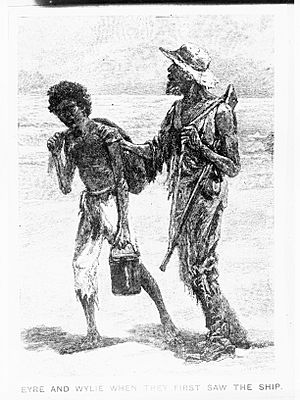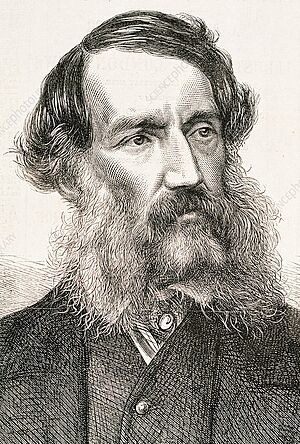Wylie (Australian explorer) facts for kids
Wylie (born around 1825) was an incredibly brave and loyal Indigenous Australian explorer, originally from the King George Sound tribe around Albany in Western Australia. He is best known for his vital and courageous role as a guide and companion to European explorer Edward John Eyre during a perilous journey across the vast and challenging Nullarbor Plain in 1841. This incredible feat of endurance and survival would have been impossible without Wylie's deep knowledge of the land, his remarkable resilience, and his unwavering loyalty.
Contents
A Glimpse into Wylie's World: Early Life and Background
Wylie was born around 1825, a time when European explorers were just beginning to venture deeply into the Australian continent. He belonged to the King George Sound tribe, an Indigenous community with a rich history and profound connection to the land around what is now Albany, in Western Australia. For thousands of years, Indigenous Australians like Wylie's ancestors had lived in harmony with the environment, developing an intricate understanding of its seasons, its resources, and its hidden pathways. This knowledge, passed down through generations, included how to find water in arid landscapes, identify edible plants, track animals, and navigate vast distances using natural landmarks.
Wylie grew up learning these essential survival skills, which were not just about staying alive but also about understanding the delicate balance of nature. His early life would have been filled with the traditions, stories, and practices of his people, preparing him, perhaps unknowingly, for the extraordinary journey that lay ahead.
The Age of Exploration: Setting the Scene
The 19th century was a period of intense exploration across the globe, and Australia was no exception. European explorers, often sponsored by governments or scientific societies, were eager to map the continent, discover its resources, and understand its geography. However, Australia's vastness, its harsh climates, and its unique landscapes presented immense challenges. Many early expeditions failed due to lack of water, food, or simply getting lost in the immense wilderness.
It quickly became clear that success in these challenging environments often depended on the invaluable assistance of Indigenous Australians. These First Nations people possessed the local knowledge, survival skills, and understanding of the land that European explorers simply did not have. They were the true experts of the Australian bush, and their guidance was often the difference between life and death. Wylie would become one of the most famous examples of such a vital partnership.
Meeting Edward John Eyre: A Journey Begins
Wylie's path first crossed with that of Edward John Eyre, a British explorer, in Western Australia. In May 1840, Wylie accompanied Eyre on a sea voyage from Albany to Adelaide, a significant journey in itself. This initial trip likely allowed Eyre to witness Wylie's capabilities and character firsthand, building a foundation of trust between them.
Eyre had ambitious plans to explore the interior of Australia, hoping to find new routes and resources. Wylie was intended to join Eyre's expedition to penetrate the interior in June of the same year. However, fate intervened, and Wylie fell ill, preventing him from joining the initial departure. This was a setback, but it wasn't the end of their shared adventure.
Later in 1840, Eyre found himself at Fowlers Bay, a remote location in Western Australia, having retreated from an earlier attempt to push north. It was here that Wylie, having recovered from his illness, rejoined Eyre. He arrived by way of the Hero, a ship that was supplying the expedition. This reunion marked the true beginning of their legendary partnership, as they prepared for one of the most challenging expeditions in Australian history.
The Epic Crossing of the Nullarbor Plain (1841)
The Nullarbor Plain is one of the most desolate and formidable landscapes on Earth. Its name, derived from Latin, literally means "no trees," and it lives up to that description. It's a vast, flat, treeless, and incredibly arid expanse that stretches for hundreds of kilometers along the southern coast of Australia. Crossing it was a monumental undertaking, fraught with danger at every turn.
In 1841, Edward John Eyre, accompanied by Wylie and two other Aboriginal companions named Joey and Yarry, along with an overseer named John Baxter, embarked on their final, desperate attempt to cross this formidable plain. Their goal was to reach Albany, Western Australia, from Fowlers Bay, South Australia.
Challenges and Hardships
The journey was a relentless test of endurance. The party faced:
- Extreme Heat: The sun beat down mercilessly, making every step a struggle.
- Severe Water Scarcity: Finding fresh water was the most critical challenge. They relied on small, often brackish, rock holes or dew collected from plants.
- Lack of Food: Game was scarce, and the land offered little in the way of edible plants.
- Isolation: They were thousands of kilometers from any European settlement, completely reliant on their own resources and skills.
- Mental and Physical Exhaustion: The constant struggle against the elements took a heavy toll on everyone.
A Test of Loyalty and Survival
During the expedition, the party experienced moments of extreme desperation. At one point, while resting at the sandhills of present-day Eucla, Wylie and Joey briefly left the main party. This was not an act of abandonment but a desperate attempt to find food in the barren landscape. They soon returned, having failed to find any sustenance, highlighting the extreme conditions they were facing. This incident underscored the constant struggle for survival and the immense pressure everyone was under.
However, it was several weeks later that Wylie's loyalty was truly put to the ultimate test. During a period of immense hardship and danger, when two other members of the party, Joey and Yarry, decided to leave the expedition, Wylie made the courageous choice to remain with Edward John Eyre. This decision was incredibly brave, as it meant facing the vast, unknown wilderness with only one other person. Wylie's unwavering commitment to Eyre during this critical time was a testament to his character and the bond that had formed between them.
Wylie's Indispensable Role
Throughout the journey, Wylie's knowledge was absolutely vital. He was the party's eyes and ears in the wilderness. He could:
- Track Animals: Helping them find scarce food sources.
- Locate Water: Guiding them to hidden rock holes and underground springs that Eyre would never have found on his own.
- Navigate: Using his deep understanding of the land to find the safest and most efficient routes.
- Interpret Signs: Reading the subtle clues of the environment to predict weather changes or identify dangers.
His skills were not just helpful; they were essential for their survival. Without Wylie, Eyre's expedition would almost certainly have perished in the vastness of the Nullarbor.
A Moment of Relief
After months of unimaginable hardship, Eyre and Wylie finally reached Rossiter Bay, where they encountered French whalers. This was a moment of immense relief and a sign that they had survived the impossible. The whalers were reportedly impressed by Wylie's "voracious appetite," a clear indication of the extreme hunger and deprivation he had endured during the epic journey. This meeting marked the beginning of the end of their perilous crossing, and soon after, they completed their journey to Albany.
Life After the Expedition: A Deserved Recognition
After the completion of the grueling journey across the Nullarbor, Wylie returned to his home in Albany. His incredible contribution to the expedition did not go unnoticed. For a brief period, he served as a "native policeman," a role that involved helping to maintain peace and order, often acting as a bridge between the Indigenous community and the European settlers. This position reflected the respect and trust he had earned.
Edward John Eyre, deeply grateful for Wylie's loyalty and indispensable help, ensured that Wylie received a government pension. This was a significant recognition of his invaluable service and a way to provide him with some financial security. Eyre and Wylie remained in contact for several years after the expedition, a testament to the strong bond of respect and shared experience that had formed between them during their extraordinary journey.
Wylie's Enduring Legacy and Importance
Wylie's story is a powerful reminder of the vital, yet often overlooked, role that Indigenous Australians played in the early exploration of the continent. He was not just a guide; he was a co-explorer, a survivor, and a hero whose knowledge and courage were absolutely fundamental to the success of one of Australia's most challenging expeditions.
Why Wylie is Important Today
- Symbol of Resilience: His ability to endure extreme hardship and remain loyal in the face of danger makes him a symbol of human resilience and determination.
- Indigenous Knowledge: Wylie's story highlights the profound and essential knowledge that Indigenous Australians possessed about their land. It underscores the importance of respecting and learning from this ancient wisdom.
- Cross-Cultural Cooperation: Despite the complex historical context of European settlement, Wylie's partnership with Eyre demonstrates how cooperation and mutual respect could lead to extraordinary achievements.
- Historical Recognition: His story ensures that the contributions of Indigenous people to Australia's history are acknowledged and celebrated.
Wylie's incredible journey has been remembered and retold over the years. For instance, Eyre's expedition, with Wylie's crucial role, was dramatised in the 1962 Australian radio play Edward John Eyre by Colin Thiele, bringing his story to a wider audience.
Today, as we look back, Wylie stands as a towering figure in Australian history. His legacy is not just about surviving a harsh landscape, but about demonstrating the power of human connection, loyalty, and the invaluable wisdom of Indigenous cultures. He reminds us that true exploration is often a collaborative effort, built on respect and shared purpose.





